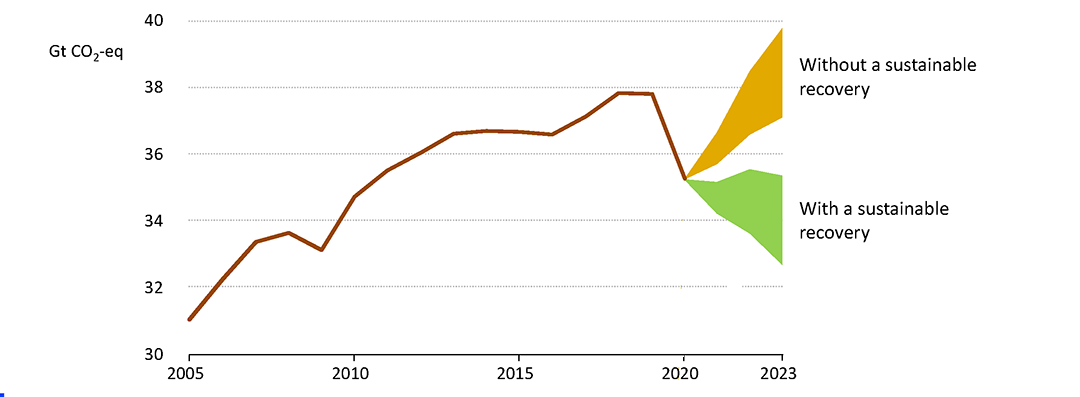Moreover, the pandemic has caused the deaths of more than a half million people, surging daily new cases, hundreds of millions of jobs lost, and an expected 6 percent drop in global GDP for the year—hardly a model for sustainable climate solutions. However, rebounding emissions are not inevitable, as shown in the figure above. In this timely new report, IEA advises governments around the world on how they can create jobs and reboot their economies while also accelerating the transition to a sustainable clean energy future.
The Sustainable Recovery Plan proposes myriad policy options for governments to institute in the next three years, spanning the electricity, transportation, industry, building, fuel, and emerging technology sectors. Developed in partnership with the International Monetary Fund, the plan analyzes more than 30 energy policy measures that IEA projects would:
- Require global investment of about $1 trillion (USD) annually over the next three years (less than 1 percent of global GDP).
- Decrease energy-related greenhouse gas emissions by 4.5 billion metric tons below business-as-usual projections in 2023 and make 2019 the definitive peak for global emissions.
- Put the world on a path towards achieving long-term climate goals, including the Paris Agreement.
- Save or create approximately 9 million jobs annually over the next three years.
- Add 1.1 percentage points to global economic growth each year.
Policy recommendations range from the expected (accelerate wind and solar deployment, minimize methane leaks from oil and gas operations, retrofit buildings to improve efficiency) to the aspirational (proliferate carbon capture technology, expand use of modular nuclear reactors). Yet the plan successfully grounds all of its recommendations in sound technological and economic analysis and makes the case that these policies are not only what is right for the climate, but also what is advantageous for the economy.
Many of IEA’s recommendations are aligned with C2ES’ own recommendations for economic recovery here in the U.S., including modernizing power and transportation infrastructure and investing in carbon capture, utilization, and storage technology.
IEA notes that its plan “is not intended to tell governments what they must do. It seeks to show them what they can do.” However, when it comes to climate change, it is clear that the gap between what is possible and what is necessary is rapidly closing. Low-income and resource-stressed communities are already experiencing the devastating effects of climate change. These vulnerable populations have and will continue to bear the brunt of economic and health crises without targeted protective policies, a fact the COVID pandemic has thrown into sharp relief. It is therefore imperative that governments take purposeful action on climate change mitigation and adaptation.
Intentional policies are needed to avoid this potential emissions increase and its associated climate effects. A recent study by the Yale School of Forestry and Environmental Studies estimates that COVID-driven delays in renewable and transportation investment alone could result in an additional 2,500 million metric tons of carbon dioxide from 2020 to 2035, which is equal to about half of U.S. carbon emissions in 2019.
That is why it’s important that governments act quickly and decisively. Economic growth and greenhouse gas emissions must continue to be decoupled, and these strategies can help make that a reality. Compared with 2008-2009, renewable energy and battery technologies are now vastly more cost effective and scalable. Moreover, IEA notes that global energy demand for renewables has stayed relatively stable during COVID, while demand for coal, natural gas, and oil have plummeted.
To increase awareness of the recommended policies, IEA held a July 9 summit of government and business leaders to discuss plans for a green recovery. Notably, the summit is the only major international meeting on climate this year, as most climate gatherings, including COP26, have been postponed to 2021 due to COVID. The summit’s participating countries included the United States and represented 80 percent of global carbon emissions.
We cannot afford to further delay progress on critical climate mitigation. While this pandemic has battered the global economy (and with it, clean energy investments), it has also set the stage for a possibly unprecedented level of government support that can leverage private investment and drive our necessary sustainable energy future. Perhaps the feel-good story we all yearn for is a future where emissions cuts are the result of sound policy, rather than reduced economic output. It’s incumbent upon our elected officials and decision-makers to bring this chance to fruition.

